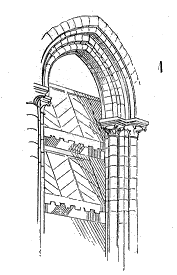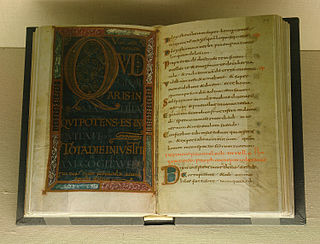A Gallicism can be:
A Gallicism can be:

Gregorian chant is the central tradition of Western plainchant, a form of monophonic, unaccompanied sacred song in Latin of the Roman Catholic Church. Gregorian chant developed mainly in western and central Europe during the 9th and 10th centuries, with later additions and redactions. Although popular legend credits Pope Gregory I with inventing Gregorian chant, scholars believe that it arose from a later Carolingian synthesis of the Old Roman chant and Gallican chant.
Gallic is an adjective that may describe:
In linguistics, a calque or loan translation is a word or phrase borrowed from another language by literal word-for-word or root-for-root translation. When used as a verb, "to calque" means to borrow a word or phrase from another language while translating its components, so as to create a new lexeme in the target language. For instance, the English word "skyscraper" has been calqued in dozens of other languages, combining words for "sky" and "scrape" in each language. Another notable example is the Latin weekday names, which came to be associated by ancient Germanic speakers with their own gods following a practice known as interpretatio germanica: the Latin "Day of Mercury", Mercurii dies, was borrowed into Late Proto-Germanic as the "Day of Wōđanaz" (Wodanesdag), which became Wōdnesdæg in Old English, then "Wednesday" in Modern English.

The Ambrosian Rite is a Catholic Western liturgical rite, named after Saint Ambrose, a bishop of Milan in the fourth century, which differs from the Roman Rite. It is used by some five million Catholics in the greater part of the Archdiocese of Milan, in some parishes of the Diocese of Como, Bergamo, Novara, Lodi, and in the Diocese of Lugano, Canton of Ticino, Switzerland.
Gallican may refer to:
In the Western Church of the Early and High Middle Ages, a sacramentary was a book used for liturgical services and the mass by a bishop or priest. Sacramentaries include only the words spoken or sung by him, unlike the missals of later centuries that include all the texts of the mass whether read by the bishop, priest, or others. Also, sacramentaries, unlike missals, include texts for services other than the mass such as ordinations, the consecration of a church or altar, exorcisms, and blessings, all of which were later included in Pontificals and Rituals instead.

An abat-son is an architectural device constructed to reflect or direct sound in a particular direction. It consists of large louvers. The term is commonly used to refer to angled louvers in a bell tower or belfry designed to redirect sound or to prevent ingress of water.
The Gallican Rite is a historical form of Christian liturgy and other ritual practices in Western Christianity. It is not a single liturgical rite but a Latin liturgical rites that developed within the Latin Church, which comprised the majority use of most of Western Christianity for the greater part of the 1st millennium AD. The rites first developed in the early centuries as the Syriac-Greek rites of Jerusalem and Antioch and were first translated into Latin in various parts of the Western Roman Empire Praetorian prefecture of Gaul. By the 5th century, it was well established in the Roman civil diocese of Gaul, which had a few early centers of Christianity in the south. Ireland is also known to have had a form of this Gallican Liturgy mixed with Celtic customs.

The term "Celtic Rite" is applied to the various liturgical rites used in Celtic Christianity in Britain, Ireland and Brittany and the monasteries founded by St. Columbanus and Saint Catald in France, Germany, Switzerland, and Italy during the early middle ages. The term is not meant to imply homogeneity; instead it is used to describe a diverse range of liturgical practices united by lineage and geography.

Pre-Tridentine Mass refers to the variants of the liturgical rite of Mass in the West before 1570, when, with his bull Quo primum, Pope Pius V made the Roman Missal, as revised by him, obligatory throughout the Latin Church, except for those places and congregations whose distinct rites could demonstrate an antiquity of two hundred years or more.

Latin liturgical rites, or Western liturgical rites, is a large family of liturgical rites and uses of public worship employed by the Latin Church, the largest particular church sui iuris of the Catholic Church, that originated in Europe where the Latin language once dominated. Its language is now known as Ecclesiastical Latin. The most used rite is the Roman Rite.

The Dominican Rite is the unique liturgical rite of the Dominican Order in the Catholic Church. It has been classified differently by different sources – some consider it a usage of the Roman Rite, others a variant of the Gallican Rite, and still others a form of the Roman Rite into which Gallican elements were inserted.
The Communion is a refrain sung with psalm recitation during the distribution of the Eucharist in the Divine Liturgy or Mass. As chant it was connected with the ritual act of Christian communion.
Gallican chant refers to the liturgical plainchant repertory of the Gallican rite of the Roman Catholic Church in Gaul, prior to the introduction and development of elements of the Roman rite from which Gregorian chant evolved. Although the music was largely lost, traces are believed to remain in the Gregorian corpus.
Ambrosian chant is the liturgical plainchant repertory of the Ambrosian rite of the Roman Catholic Church, related to but distinct from Gregorian chant. It is primarily associated with the Archdiocese of Milan, and named after St. Ambrose much as Gregorian chant is named after Gregory the Great. It is the only surviving plainchant tradition besides the Gregorian to maintain the official sanction of the Roman Catholic Church.
Mozarabic chant is the liturgical plainchant repertory of the Visigothic/Mozarabic rite of the Catholic Church, related to the Gregorian chant. It is primarily associated with Hispania under Visigothic rule and later with the Mozarabs and was replaced by the chant of the Roman rite following the Christian Reconquest of the Iberian Peninsula. Although its original medieval form is largely lost, a few chants have survived with readable musical notation, and the chanted rite was later revived in altered form and continues to be used in a few isolated locations in Spain, primarily in Toledo.
Old Roman chant is the liturgical plainchant repertory of the Roman rite of the early Christian Church. It was formerly performed in Rome, and, although it is closely related to Gregorian chant, the two are distinct. Gregorian Chant gradually supplanted Old Roman Chant between the 11th century and the 13th century AD. Unlike other chant traditions, Old Roman chant and Gregorian chant share essentially the same liturgy and the same texts. Many of their melodies are also closely related. Although primarily associated with the churches of Rome, the Old Roman chant was also performed in parts of central Italy, and it was possibly performed much more widely.
Celtic chant is the liturgical plainchant repertory of the Celtic rite of the Catholic Church performed in Britain, Ireland and Brittany. It is related to, but distinct from the Gregorian chant of the Sarum use of the Roman rite which officially supplanted it by the 12th century. Although no Celtic chant was notated, some traces of its musical style are believed to remain.

There exist a number of translations of the Book of Psalms into the Latin language. They are a resource used in the Liturgy of the Hours and other forms of the canonical hours in the Latin liturgical rites of the Catholic Church.
Western Rite Orthodoxy, also called Western Orthodoxy or the Orthodox Western Rite, are congregations within the Eastern Orthodox tradition which perform their liturgy in Western forms.